Safe Exercise For Pregnancy
Maintaining a regular exercise program throughout your pregnancy can help you stay healthy and feel your best. This exercise course is perfect for your pregnancy journey and will help you feel equipped with the tools needed to take control of your pregnancy health and wellness. Our goal is to help you stay fit, and to make sure that you know exactly what to do and what not to do during pregnancy exercising.
Overall and in most cases, exercise is safe during pregnancy. You will usually find it is even recommended. Typically, the first rule of thumb is if you were physically active before you were pregnant, it is likely safe to remain active during pregnancy. More than likely, your healthcare provider will tell you to remain active, as long as it is comfortable and there are no other health conditions suggesting otherwise.
Now is not the time to exercise for weight loss, however, proper exercise during pregnancy will likely help with weight loss after the delivery of your baby. Exercise does not put you at risk for miscarriage in a normal pregnancy. You should consult with your health care provider before starting any new exercise routine.
Benefits of Exercise while pregnant
If you think of exercise solely as a way to fit into a smaller pair of pants, you may need to shift your perspective (and priorities) now that you’re pregnant. Exercising during pregnancy can lead to a lower incidence of:
- preterm birth
- cesarean birth
- excessive weight gain
- gestational diabetes or hypertensive disorders such as preeclampsia
- lower birth weight
It’s also a best way to:
- manage symptoms of depression and anxiety
- reduce stress
- improve postpartum recovery
- maintain physical fitness
- reduce low back pain (hello, growing tummy!)
Safety tips for exercise while pregnant
With that in mind, here are some general safety tips to consider when exercising during pregnancy, according to the ACOG.
- Don’t become overheated, especially during the first trimester.
- Get clearance from your doctor if you’re new to exercise or you have any health conditions that may contraindicate exercise.
- Avoid lying flat on your back for too long, especially during the third trimester.
- Avoid contact sports and hot yoga.
- Drink plenty of water before, during, and after exercise.
- Wear supportive clothing such as a supportive sports bra or belly band.
Exercise to do on the first trimester of pregnancy
The first three months of pregnancy can be a wild ride of emotions. From elation and pure joy to concern, worry, and even fear as you begin to realize that you’re responsible for nourishing, growing, and keeping this tiny soon-to-be human being safe and healthy. The foundation of a well-rounded prenatal fitness routine should include at least 150 minutes of cardiovascular activity each week and 2 to 3 days of strength training exercises that target the major muscle groups. Doing an exercise like the pelvic curl is a great way to begin working on spinal mobility and strengthening the abdominal muscles that will support your belly as it grows.
Squats
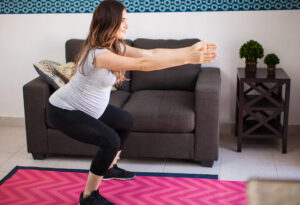
The first trimester is also an ideal time to get squatting! If you have access to the gym, you can also use the leg press machine. Squats — especially bodyweight squats — can be done throughout your entire pregnancy.
- Squat down like you’re about to sit down on the couch, but come back up just as your thighs start to touch it.
- Stand in front of a couch, with your back facing the couch. Begin with feet just wider than hip-width apart. Use the couch as a guide to ensure proper form.
- Do 2 sets of 15 to 20 reps.
- Make sure you take 5 seconds to go down 3 seconds to come back up.
- Exhale as you squat; inhale as you stand.
Kneeling pushups
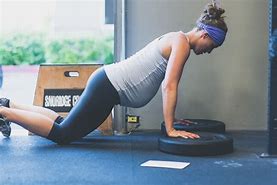
This move targets core and upper body strengthening together.
- Exhale as you press back up.
- Start with 6 to 10 and gradually work up to 20 to 24 reps.
- Pull in your abs (the pelvic brace), and then slowly lower your chest toward the floor as you inhale.
- Lie flat on your stomach, then push up onto your hands and knees, keeping your knees behind your hips.
Pelvic curl

- Lie on your back with your knees bent and feet flat on the ground, about hip-width apart.
- Take a deep breath in to prepare, then exhale as you tuck your pelvis (your “hips”) so that you’re making an impression of your spine on the floor.
- Keep that tucked position as you continue the exhale and roll through the movement so that you are lifting your spine out of that impression, one vertebra at a time.
- Stop when you reach your shoulder blades.
- Inhale at the top of the movement, then exhale as you fold your body back down, placing one vertebra at a time back onto the floor until you get to your starting position on the back of your pelvis (your “hips,” as many people will refer to them as).
- Do 12 to 15 reps. For an added challenge, bring your legs all the way together.
Bicep curl

This simple yet effective move is another top pick throughout pregnancy. Jeffcoat says bicep curls are a key move to add to your workouts since you need to prep your arms for repeatedly lifting and holding your baby.
- Grab 5- to 10-pound dumbbells and stand with your feet slightly wider than your hips and your knees slightly bent.
- Exhale as you slowly bend your elbows, bringing the dumbbells toward your shoulders.
- Inhale and slowly lower the weights back down.
- Take 3 seconds to lift the dumbbells and 5 seconds to lower.
- Do 2 sets of 10 to 15 repetitions.
Exercise to do on the second trimester of pregnancy
Once the reality sets in that you’re in this for the long haul, you may notice a feeling of calmness and even an increase in energy over the next several weeks. Many women say this is the trimester where they feel the best, which is why it’s an excellent time to focus on your fitness routine.
Mermaid stretch
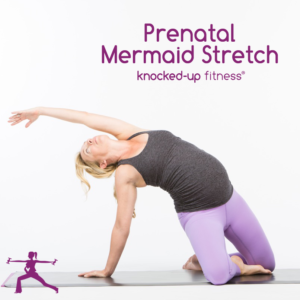
As your baby grows, it can start to create pressure on your diaphragm and ribs that can be painful.
- it on the ground with both of your knees bent (or folded) and your feet facing to the right.
- Raise your left arm straight to the ceiling as you inhale, then exhale and side bend your torso toward the right. The stretch should be felt on the left side in this example. Hold for 4 slow, deep breaths. This would be the direction to stretch if you experience discomfort on the left side.
- Reverse directions for discomfort on the right side. To reduce the risk of this occurring, start stretching both directions during the second trimester.
Incline pushups

- Stand facing a ledge or railing and place your hands shoulder-width apart on the surface.
- Step your body back into a standing plank position with your back in a straight line.
- Bend your arms and slowly lower your chest toward the railing or ledge.
- Straighten your arms to return to the starting position.
- Do 2 sets of 10 to 12 repetitions.
Side-lying left lifts
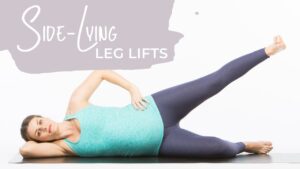
To prepare for your changing center of gravity, it’s important to get the muscles that help with balance and assist in pelvic stabilization stronger.
- Lie on your right side with both knees bent and stacked on top of one another.
- Slightly lift your right side off of the floor to create a small gap between your waist and the floor. This also levels your pelvis.
- Straighten your left leg and angle it slightly in front of you. Rotate your hip so that your toes point down toward the floor.
- Exhale as you take about 3 seconds to lift your leg; inhale for 3 seconds back down. As you lift your leg, make sure you don’t lose that little gap you created between your waist and the floor.
- Do 2 sets of 8 to 15 repetitions on each side.
Hip flexor and quadriceps stretch
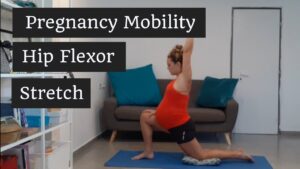
Because of your changing center of gravity, the belly tends to fall forward, creating shortened hip flexor muscles. This exercise allows you to safely stretch during pregnancy.
- Go into a half-kneeling position on the floor. Place your right knee on the floor and your left foot in front of you, left foot flat on the floor.
- Keeping your posture nice and tall, lunge toward your left foot until you feel a stretch in the front of your right hip and thigh.
- Hold for 30 seconds, ease off, and then repeat 2 more times.
- Switch sides and repeat.
Exercise to do on the third trimester of pregnancy
You’ll definitely notice a slowdown if not an abrupt halt at times during the third trimester, as your body begins to prepare for labor and childbirth. This is a great time to focus on cardiovascular activities and keep up your mobility and abdominal strength with:
- bodyweight moves
- pelvic floor exercises
- walking
- swimming
- prenatal yoga
- Pilates
Note: These help to keep your upper and lower body muscles strong.
Diastasis recti correction

Diastasis recti (separation of the rectus abdominal muscles) is a concern for women during this time, and it will show up as a bulge that runs down the midline of your abdomen.
- Lie on your back with a pillow under your head and shoulders. Knees are bent, and feet are flat on the floor.
- Use a crib or twin sheet and roll it so it’s about 3 to 4 inches wide, and place it on your lower back (above your pelvis and below your ribs).
- Grab the sheet and cross it once over your abdomen. Then, grasp the sides, and the sheet should form an X as you pull each side.
- Take a deep breath in to prepare, then press your back flat into the floor as you raise your head and shoulders off of the pillow. During this motion, you are gently “hugging” the sheet around your abdomen to support your abs.
- Inhale lower, and repeat 10 to 20 times. If your neck or shoulders hurt, start at 10 and work your way up.
- Do this 2 times a day.
For your information and safety of you and baby: Make sure to listen to your body and stop if you feel any discomfort or pain. And as always, talk with your doctor if you have any questions or concerns about how your body is responding to an exercise program.



[…] Flexibility and strength training For Expectant moms […]